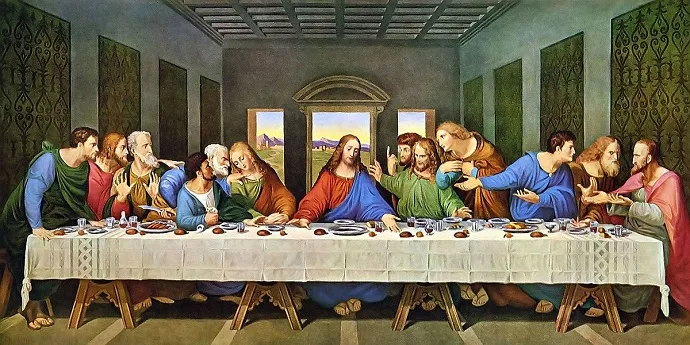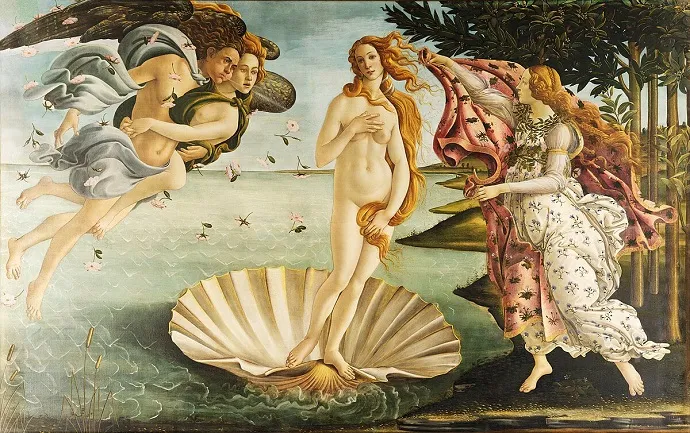Italian oil painting has experienced a glorious history of development, leaving a deep mark on world culture. From Renaissance masterpieces to innovative modern works, Italian oil paintings are not only symbols of beauty but also testaments to the talent and soul of great artists.
In this article, join “Du lịch khắp thế gian” to explore the most famous Italian oil paintings, immerse yourself in the colorful and emotional world of art, and gain a deeper understanding of the history, culture, and people of this land.
1. The Last Supper – Leonardo da Vinci
The Last Supper by Leonardo da Vinci is one of the most famous and influential oil paintings in art history. Painted between 1495 and 1498 on the wall of the Santa Maria delle Grazie monastery in Milan, the painting depicts the last meal of Jesus with his disciples.
The painting is not only famous for its masterful painting technique but also for da Vinci’s ability to capture and express the emotions of each character. The moment Jesus announces that one of them will betray him creates a wave of strong emotions, from astonishment and confusion to anger and fear, all vividly expressed on the faces of the disciples. The Last Supper is a timeless masterpiece, demonstrating da Vinci’s masterful talent in combining art and psychology.

2. The Birth of Venus – Sandro Botticelli
“The Birth of Venus” is a famous painting by Sandro Botticelli, created in the 1480s. The painting depicts the goddess Venus standing on a seashell, being blown ashore by the wind gods Zephyr and Aura, and greeted by a goddess, possibly Hora of Spring.
The painting is done on canvas and is considered a symbol of the city of Florence (Italy) and a masterpiece of Renaissance art. “The Birth of Venus” is not only a beautiful work of art but also a symbol of innovation and the revival of art and culture during the Renaissance.

3. Annunciation – Leonardo da Vinci
“Annunciation” is another famous oil painting by Leonardo da Vinci, painted around 1472-1475. The painting depicts the scene of the Archangel Gabriel announcing to the Virgin Mary that she will conceive and give birth to Jesus.
This work demonstrates da Vinci’s sophistication in using light and shadow to create depth and vitality for the characters. The delicate face and gentle expression of the Virgin Mary, along with the majestic and solemn appearance of the angel Gabriel, create a painting that is both sacred and intimate. “Annunciation” is a testament to da Vinci’s diverse talents, not only as a scientist and engineer but also as a master artist.
4. The Entombment – Caravaggio
“The Entombment” is an emotionally charged oil painting by Caravaggio, painted in 1603-1604. The painting depicts the scene of Jesus being lowered from the cross and prepared for burial.
Caravaggio’s painting style is evident in his use of strong light and stark contrasts, creating a dramatic and mournful space. The characters in the painting, from the grieving Virgin Mary to the disciples carrying Jesus’ body, are all depicted with genuine and profound expressions. “The Entombment” is one of Caravaggio’s most representative works, showcasing his talent for depicting powerful emotions and sacred moments.
5. David and Goliath – Caravaggio
Caravaggio is also famous for his painting “David and Goliath,” painted around 1599. The painting depicts the scene of David, the young man who defeated the giant Goliath, holding his enemy’s head.
Caravaggio’s painting style is evident in his use of strong light and stark contrasts, creating a dramatic and mournful space. The characters in the painting, from David with a victorious expression to Goliath with a horrified look, are all depicted with genuine and profound expressions. “David and Goliath” is one of Caravaggio’s most representative works, showcasing his talent for depicting powerful emotions and sacred moments.
6. The School of Athens – Raphael
Although not entirely oil painting (but rather a fresco), “The School of Athens” by Raphael, painted from 1509 to 1511 at the Vatican, is still an important work, imbued with the spirit of the Italian Renaissance. The painting depicts a gathering of the greatest philosophers, scientists, and mathematicians of ancient Greece, including Plato, Aristotle, Pythagoras, and Euclid.
“The School of Athens” is not only a beautiful work of art but also a symbol of innovation and the revival of art and culture during the Renaissance.
7. Judith Beheading Holofernes – Artemisia Gentileschi
“Judith Beheading Holofernes” is a powerful and dramatic oil painting by Artemisia Gentileschi, a talented female Italian artist of the 17th century. The painting depicts the scene of Judith, a Jewish widow, beheading General Holofernes of the Assyrian army to save her people.
This painting is famous for its realism and boldness in Gentileschi’s depiction of violence and Judith’s determination. The light focuses on the faces and actions of Judith and her maid, while darkness envelops Holofernes, creating a space full of tension and drama. “Judith Beheading Holofernes” is not only an outstanding work of art but also a symbol of women’s strength and resilience.
8. Venus of Urbino – Titian
“Venus of Urbino” is a famous oil painting by Titian, painted around 1538. The painting depicts a nude woman reclining on a bed, believed to be the goddess Venus.
“Venus of Urbino” is famous for the sensual and seductive beauty of the woman, as well as Titian’s masterful painting technique in depicting smooth skin and delicate details. This painting has caused much controversy and is considered one of Titian’s most important works, demonstrating the innovation in his depiction of beauty and sexuality in art.
9. Susanna and the Elders – Artemisia Gentileschi
Another work by Artemisia Gentileschi, “Susanna and the Elders,” also demonstrates her talent and unique style. The painting depicts the story of Susanna, a woman who is seduced and threatened by two elders.
Gentileschi has realistically and deeply expressed Susanna’s fear and helplessness. This painting is not only a beautiful work of art but also a powerful indictment of the abuse of power and injustice against women.
10. Bacchus and Ariadne – Titian
“Bacchus and Ariadne” is a colorful and energetic oil painting by Titian, painted around 1522-1523. The painting depicts the scene of the god Bacchus, the god of wine and joy, meeting Ariadne, the princess of Crete, after she was abandoned by Theseus.
This painting is famous for the vibrancy and brightness of its colors, as well as the movement and emotions of the characters. Titian has created a space full of joy and elation, expressing the combination of love, passion, and liberation. “Bacchus and Ariadne” is one of Titian’s most representative works, showcasing his talent for creating paintings full of emotion and vitality.
11. Madonna del Granduca – Raphael
“Madonna del Granduca” is a famous oil painting by Raphael, painted around 1505. The painting depicts the Virgin Mary holding the Child Jesus.
“Madonna del Granduca” is famous for the pure and gentle beauty of the Virgin Mary, as well as the warmth and love in the relationship between Mother and Child. Raphael has created a peaceful and sacred space, expressing reverence and admiration for the Virgin Mary. This painting is one of Raphael’s most representative works, showcasing his talent for creating religious paintings full of emotion and meaning.
Conclusion
The most famous Italian oil paintings are not only beautiful works of art but also historical witnesses, reflecting Italian culture, society, and people through the ages. Exploring these masterpieces will help us better understand the history of Italian art and the great contributions of Italian artists to world civilization. Hopefully, through this article, “Du lịch khắp thế gian” has brought you a deep and inspiring look at Italian oil painting art.